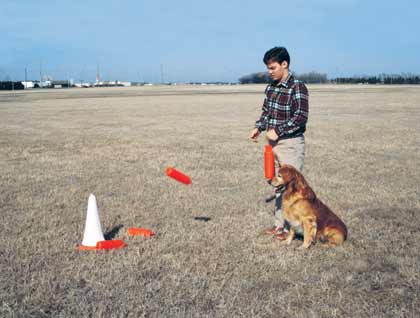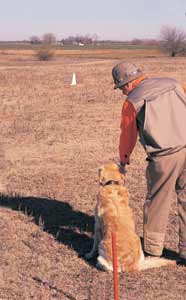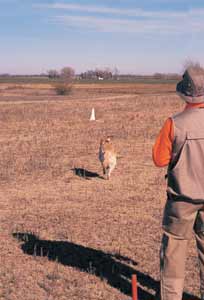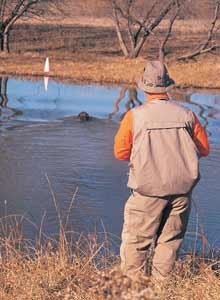The key to good lining.
By James B. Spencer
 To start, let your dog watch as you toss the dummies near the visual aid. |
You're hunting ducks, and while your Blackie is chasing down a cripple through the tules off to the left, your hunting buddy knocks down another duck that falls in a patch of cover off to the right. Blackie, of course, didn't see that fall. So, after he delivers the still-struggling cripple, you set him up for a blind retrieve and send him. He swims straight to the patch of cover and needs only one or two whistles to find the bird.
"Wow!" says your non-doggy buddy, "Blackie really took the line you gave him, didn't he?"
It certainly looked like "he took the line you gave him," but that isn't what really happened, at least not from Blackie's perspective. When you set him up, he scanned the scenery before him, picked a spot his previous experience told him might hold the bird, and "locked in" on it. In training terminology, he selected a "picture," which you confirmed with your hand and voice ("Good" or "Line"). Then, when you sent him, he proceeded with all possible dispatch directly toward that "picture" and ultimately delivered the bacon...er, duck.
Actually, Blackie did exactly what you would do if someone asked you to walk, say, 50 paces straight north. You wouldn't turn to the north, look at the ground in front of you, and start walking. If you did, you'd wander all over the pasture. Instead, you'd pick out a distant object off to the north and walk toward it. That distant object would be your "picture." Using such "pictures" is a most natural way of moving in a straight line, for both man and beast.
When I started in retrievers, which was about the time Caesar was preparing to cross the Rubicon, I often heard experienced trainers speak of "pictures."
"My dog lined the blind! He really got the picture on that one."
Or, "Oh, well, I'll see you at the next trial. I just bombed out with a 25 whistle blind, mostly because this mutt of mine didn't get a good picture at the line."
 "Dead Bird! . . . . Good . . . Back!" |
And so on. But they explained what they meant by "picture" in only vague, general ways. More importantly, no one could tell me how, in training, I could encourage my own dogs to use pictures. So, like most amateurs back then, I trained my dogs to line with mowed path pattern blinds, in which we trained our dogs to run down a path mowed through light to moderate cover to a dummy pile.
This encouraged them to focus on the path rather than on a picture of their destination. It also required that the trainers spend an inordinate amount of training time pushing a lawn mower. Consequently, most of us didn't mow paths in enough different places to allow our dogs to generalize the training properly. Worse still, this technique encouraged a dog, when on a real blind retrieve, to veer off onto any intersecting cow trail.
Thank You, Margaret Patton!
Then, one happy day in 1975, Margaret Patton of Tishamingo, Oklahoma, explained to me how she taught lining by having her dogs run to white traffic cones marking her dummy piles. The light came on: Give a retriever something visible to run to in training and he'll more quickly and easily learn to use pictures for lining! And, as Margaret explained it, it was simple: Use the visual aid (white cone, white flag, white box, whatever) to teach the dog "pattern blinds" (memory blinds) in various places, with various hazards, and then rerun him on those same pattern blinds without the visual aid.
 He's on his way and running straight at the visual aid. |
Once a dog knows a pattern blind, he will remember it for months, even years. Each new pattern blind "pastes a picture" in his "album." When set up for a real blind retrieve, he simply pages through his album until he finds a picture that matches, at least approximately, some spot he sees out in front of him. When sent, he'll run straight to it.
These visual aid pattern blinds are equally useful on land and in water, whereas mowed paths are strictly for land-lubbers.
Positive Training
No dog has any natural talent for the blind retrieve. Unlike marks, for which the retriever breeds were especially bred and for which they (at least the good ones) have remarkable talent, the blind retrieve must be totally taught. In fact, you the trainer must not only teach your dog everything he is to do in a blind retrieve, but you must also provide his motivation for doing it. (Happily, if you and he are properly bonded, he wants to please you, because he is a pack animal and you are his pack leader. Keep that in mind all through your training program. It'll make life easier for both of you.)
Clearly, when you send your retriever on a blind retrieve, you must supply the motivation as well as the direction. He has seen nothing fall, so has no natural inclination to take off running when you say, "Back!" To motivate him, you must give him either something to run to (a picture), or something to run from (punishment). A retriever well trained in blind retrieves needs much of the former and just enough of the latter to convince him that not leaving when sent is not an option.
It's been years since I've seen retrievers that were trained almost totally with "run from" techniques. They were pitiable sights to watch, tails tucked between their hind legs, heads down, and walking cautiously rather than running. Dogs trained with mostly "run to" techniques, that is, with those that encourage "pictures," are a pleasure to watch. They run "high on both ends" (head and tail) and almost as fast as on marks. Thus, training your retriever to run to pictures not only simplifies the process for both of you, but, being a strongly positive method, it also encourages your pooch to maintain whatever style his genes have provided.
More About "Visual Aid" Pattern Blinds
To teach your dog to run to a dummy pile marked with a visual aid, first put out the visual aid about 75 yards from your intended starting point or, in retriever jargon, "t
he line." Next, grab several dummies and heel your dog from the line to the visual aid. With him sitting at heel and watching, toss the dummies, one by one, near the visual aid. Then heel your dog back about 15 yards toward the line, turn, go through your blind retrieve sequence ("Dead bird . . . Good . . . Back!" or whatever), sending him. He'll run straight to the visual aid, snatch up a dummy, and prance back to you.
Heel him back another 15 or 20 yards and repeat the process, and so on. Within a session or two, he'll spot the visual aid as soon as you heel him to the line. At that point, you no longer need to heel him to the visual aid. Just put the dummies out when you set it up.
 It works in water, too. "Dead Bird! . . . . Good . . . Back!" He's swimming straight at the visual aid. |
When your dog locks in on the visual aid from the line, go through your blind retrieve sequence and send him. Run him to it two or three times; then put him up while you remove the visual aid. Get him out again and run him to the dummy pile, the location of which is well known to him by now, without the visual aid.
You can set these pattern blinds up this way in many places, both on land and in water. And he'll remember them all so well that you can run him to any of them without the visual aid.
From one line, you can set up multiple pattern blinds, fanning out at different angles like streets from a single hub, as is common in some cities. This allows you to cure your retriever of running to a "wrong" white object. First, teach each blind with the visual aid in place. Then, by removing only one visual aid, you can teach him to go where you send him when it has no visual aid and several other locations do have them.
More Pattern Blinds
My book, Retriever Training Drills for Blind Retrieves (available from the Gun Dog Book Shelf), contains more information about this visual aid pattern blind. It also describes in detail many other drills for lining, stopping and casting, which will help you teach your beastie to do blind retrieves properly and with his best style.
Nota Bene
Jim Spencer's books can be ordered from the Gun Dog Bookshelf: Training Retrievers for Marshes & Meadows; Retriever Training Tests; Retriever Training Drills for Marking; Retriever Training Drills for Blind Retrieves; Retriever Hunt Tests: A Handler's Guide to Success; HUP! Training Flushing Spaniels the American Way; and POINT! Training the All-Seasons Bird Dog.






